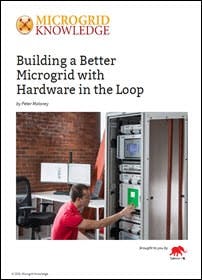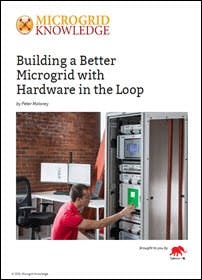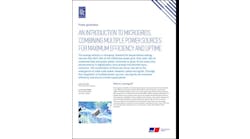Microgrid Knowledge, in partnership with Typhoon HIL, explores the possibilities of new microgrid simulation and testing tools in a special report. The following entry looks at the “three D’s” — digitalization, decentralization and decarbonization.
Download the full report.
Digitalization, decentralization and decarbonization
The electric power grid is undergoing one of the most fundamental changes since its inception over a century ago. That transformation has been summed up as the “3 Ds,” which stands for digitalization, decentralization, and decarbonization.
This value-added shift is being aided, in part, by new tools and processes, such as hardware-in-the-loop (HIL) testing and more broadly model based engineering (MBE). Using a single, coordinated virtual model as the basis for system development creates opportunities to save time and money in the design, testing, and operation, especially considering the wide variety of components that must function seamlessly to make the transformation possible and guarantee the safe, reliable and fundamentally flexible operation of the electric power grid.
Digitalization applies advances in digital technologies to the power sector. It is about making the power sector smarter and more flexible by collecting and analyzing more system and customer data, through sensors and ‘smart meters,’ and using the insights to tailor energy delivery and use via digital controllers and intelligent electronic devices. Taking the capability a step further, we can coordinate these systems to create distributed control infrastructure, using high-speed communications and technologies such as cloud computing and distributed ledger transactions, or ‘blockchain.’
The World Economic Forum estimates that digitalization will create $1.3 trillion of value globally by 2025 by increasing asset life spans, optimizing electricity flows and creating innovative customer-centric products. The digitalization of the electric industry is being propelled, and is helping to facilitate, another trend, the decentralization of energy transactions.
“You could save up to 20-30% of time by using the Hardware in the Loop testbed continuously during the design and validation of microgrid development.” — Qiang Fu, regional technology manager at Eaton.
The power industry is no longer a one-way street with power flowing from a remote centrally located power station out to end users. Increasingly, power is flowing in two directions as consumers adopt technologies that allow them to generate and store energy. Between 2000 and 2017, US rooftop solar installations grew tenfold, driven by a combination of falling solar panel prices, tax credits and innovative financing strategies for consumers. Most importantly, energy is moving from a supplier-customer model of centralized control to a peer-to-peer structure in which anyone can offer services of value to another — for example related to timing, location, delivery rate, or quality of service.
Source: The World Economic Forum
The third leg of this three-part trend is decarbonization. Both digitalization and decentralization inherently reduce primary energy use and consequently reduce emissions of carbon dioxide (CO2), one of the principal greenhouse gases. In addition, a growing number of local and state governments, as well as corporations, are embracing measures explicitly aimed at reducing CO2 emissions. To date, 29 states and the District of Columbia have adopted renewable portfolio standards that mandate lower GHG emissions, and eight states have set renewable energy goals. Four states — California, Hawaii, New Mexico and Washington — now have laws that call for them to move to 100% clean energy over the coming decades.
Grid disrupting technologies
Those states are responding to increasing concerns about rising temperatures, as well as the potential for more frequent and devastating natural disasters, such as hurricanes, wildfires and flooding. Some of those same concerns also fuel the growth of microgrids.
The global market for microgrids is expected to expand from $6.3 billion in 2018 to $30.9 billion by 2027, with most of the demand coming from Asia and North America, according to Navigant Research.
For most of its history, the electric power sector has been dominated by companies that enjoyed monopoly power in their markets.
Increasingly, communities install microgrids to improve flexibility and response capability in case of flooding or severe storms and to retain continuity of critical services during emergencies.
Source: Navigant Research
Microgrids are well suited to meet those needs. They are small self-contained electrical systems that integrate various local energy technologies — for example renewables, small-scale fossil generation, and batteries—enabling responsive generation and distribution of electric power, as well as services such as heating and cooling. They can operate in concert with the larger network and become particularly valuable during natural disasters.
The proliferation of microgrids highlights the differences between the centralized market structure of the past and the evolving taxonomy of a networked grid comprised of microgrids and distributed energy resources (DERs) such as solar power installations — both rooftop and stand-alone — and energy storage devices.
Benefits and challenges
The spread of the networked grid brings with it several benefits, as well as challenges. Among the benefits microgrids and DERs bring to the power sector are new business models that help promote greater competition and innovation.
For most of its history, the electric power sector has been dominated by companies that enjoyed monopoly power in their markets. They had little incentive to do things differently or to innovate. Microgrids and DERs are changing that.
There are multiple vendors in the microgrid and DER market, and each is vying to gain market share by offering better technology or better customer service or a combination of the two.
The costs of the technologies behind microgrids and DERs are coming down, particularly for solar panels and lithium-ion batteries. Lower costs make these resources more competitive with legacy technologies and enable them to grow market share. And, as they become more prevalent, consumers reap the benefits of their reduced costs.
Microgrids and DERs also have an advantage in that they often can be brought to market more quickly than centralized generation. A solar farm or battery energy storage facility can be installed rapidly to meet local market needs, while small-scale gas-fired power plants can quickly ensure power wherever natural gas is available. In either case, speed to market can also translate into a quicker return for investors and speedier regulatory recovery for utilities.
Microgrids and DERs are flexible. Locally installed solar panels can reduce dependency on transmission assets; batteries help shift time availability and can provide back-up power in an emergency. Batteries can also provide voltage and frequency support for the wider grid. Depending on the technology they employ, microgrids also may be able to supply several other products and services, such as chilled water and steam for industrial uses.
“HIL is invaluable in risk mitigation.” — Qiang Fu, regional technology manager at Eaton
Finally, microgrids and DERs provide consumers with a wider array of choices for how they use their energy. They give consumers control over their energy use, enabling them to reduce their bills through demand response or other energy saving programs; they also give consumers more say over the kinds of energy they use. They can install a microgrid, for example, that uses more renewable energy compared to their local utility.
Over the next few weeks, the Microgrid Knowledge series on new microgrid simulation and testing techniques will cover the following topics:
- Facing the Challenge & microgrid testing in real time
- Using HIL to create a microgrid testbed
- Verification of protection coordination
Download the full report, “Building a Better Microgrid with Hardware in the Loop,” free of charge courtesy of Typhoon HIL.








